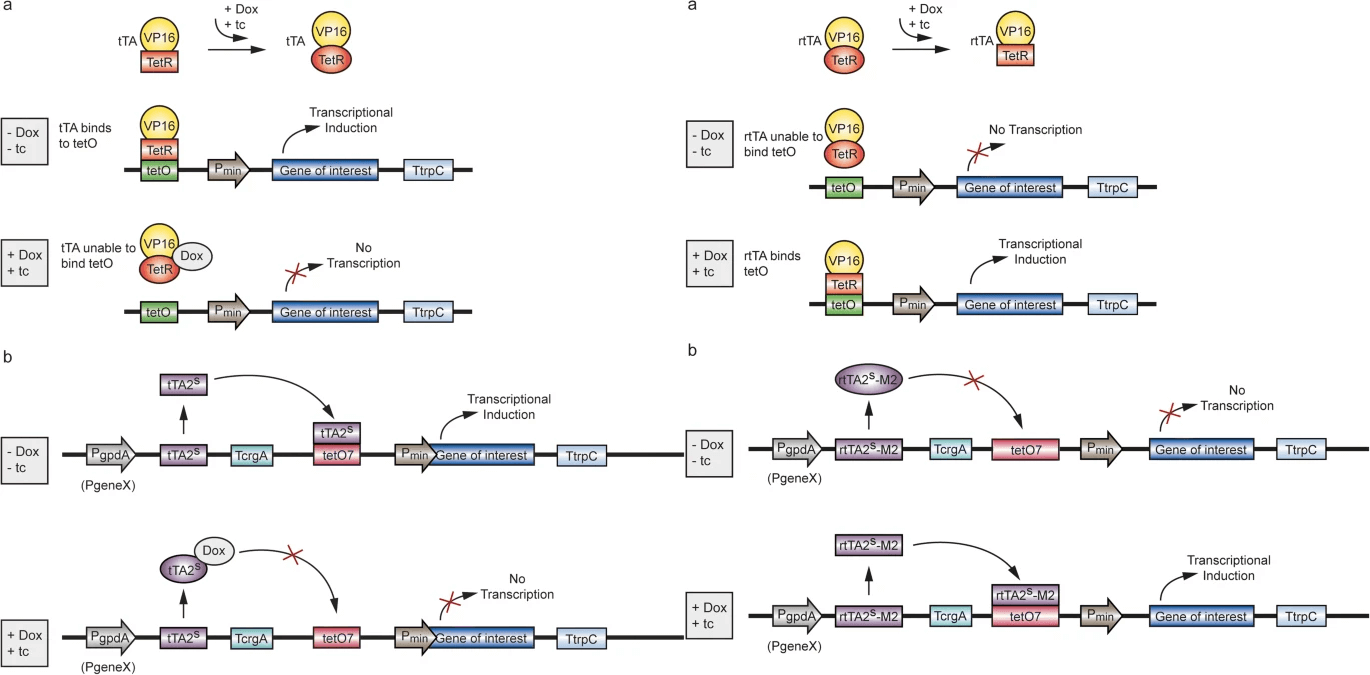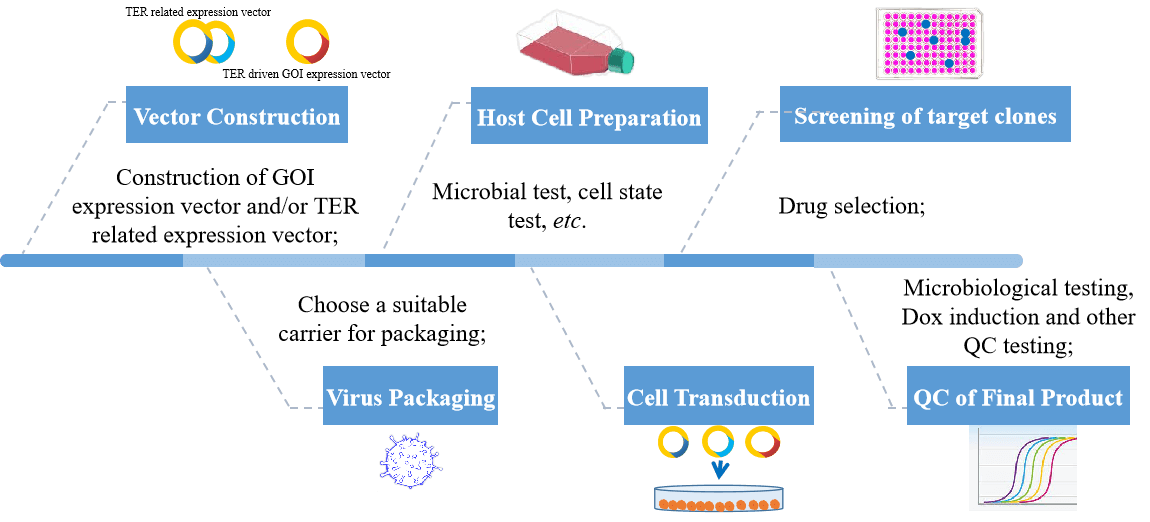Induced Expression Stable Cell Line Construction Service
Creative Bioarray has many years of experience in stable cell line construction services, and can provide stable cell line products after gene editing. Our gene-editing platform can successfully achieve the conditional expression of GOI using inducible expression promoters. On the experimental platform with the most cutting-edge technology and equipment, our expert team will provide you with the best solution for stable cell lines.
Inducible Promoter System
A strictly controlled conditional expression system is essential for the functional characterization of genes. The induction of transgenes required for expression in mammalian cells and animals is a priority in current basic and applied research, biopharmaceutical manufacturing, gene therapy and tissue engineering, and drug discovery. The most prominent human compatible transgene control technology is the engineered promoter/transactivator configuration, which can adjust the transcription of heterologous target genes according to clinically approved antibiotics (tetracycline, streptomycin, macrolide). The conditional expression system also has great application potential for the construction of stable cells. At present, the most widely used technology in eukaryotic cells is to use an inducible promoter system to achieve conditional expression, such as an inducible promoter that depends on a carbon source, an inducible promoter system that does not depend on metabolism, and so on.
Many inducible promoter systems have been developed in production to allow time control of genetically modified cell lines such as shRNA transcription. For example, a common inducible expression mechanism originating in E. coli is the tetracycline (tc) expression system (Tet system). The core component of the Tet system is derived from the Tn10 tetracycline resistance operon. The TetA protein residing on the membrane is responsible for the reverse transport of tc leading to resistance to this antibiotic.
Tet System Used in Our Service
Tet-Off & Tet-On
The tetA gene is under the transcriptional control of tc-dependent Tet repressor protein (TetR), which negatively controls tc resistance. In the absence of tc, TetR binds to the tet operon (tetO), causing the transcription of the operon to be turned off. On the contrary, in the presence of tc, the interaction between the repressor and the operon is effectively prevented, resulting in the dissociation of TetR from tetO.
In order to be used in eukaryotes, the regulatory elements must be modified and a distinction is made between Tet-On and Tet-Off systems. The tc-dependent transactivator (tTA) is produced by fusing TetR with the transcription activator domain from herpes simplex virus protein 16 (VP16). By adding tc or its analog doxycycline (Dox), tTA cannot specifically bind to tetO; therefore, the transcription of the gene of interest is disrupted (Tet-Off state). In contrast, for the Tet-On system, a reverse hybrid tTA (rtTA) was constructed, which acts as an activator of gene expression in the presence of tc or Dox.
 Fig 1. Schematic diagram of the eukaryotic Tet system (left: Tet-Off expression system; right: Tet-On expression system). (Kluge J, et al. 2018)
Fig 1. Schematic diagram of the eukaryotic Tet system (left: Tet-Off expression system; right: Tet-On expression system). (Kluge J, et al. 2018)
Induced Expression Cell Line Construction Service
Our technology platform provides a variety of vector customization services for efficient delivery of tetracycline-inducible gene expression cassettes to target cells. Through this service, customers can achieve GOI expression regulated by Tet. You can choose Tet-On and Tet-Off systems to help you achieve the highly specific, dose-dependent controlled expression of GOI's tetracycline. This service can be customized to construct Tet-inducible gene expression stable cell lines, through the simultaneous co-expression of GOI driven by the TRE promoter and Tet regulatory proteins (tTA, tTS and/or rtTA) in target cells to achieve tetracycline-regulated GOI induction or inhibition. We use plasmids/viruses that can carry GOI driven by TRE for transfection/transduction to achieve the flexible experimental design and reliable Tet-induced gene expression. The construction of Tet-Off can be used with gene knockdown services to achieve time control of shRNA expression. For Tet-On stable cell lines, we also provide fusion proteins that express tTS and rtTA as tissue-specific promoters to help you achieve tissue-specific induction of GOI.
 Fig 2. Tet-induced gene expression cell line construction service process.
Fig 2. Tet-induced gene expression cell line construction service process.
After the final cell line is formed, we will verify the induced expression of GOI by RT-qPCR. In addition, this service also provides a series of standard QC test reports, including genetic stability testing, sterility testing and mycoplasma testing to release the final cell line products. Our inducible expression stable cell line construction service has the advantages of minimal background expression and high GOI induction. The progress of the whole service process is transparent, and high-quality services are provided while ensuring speed.
Creative Bioarray provides a variety of technical services from the construction of Tet-induced expression vectors to the formation of stable cell lines, helping customers to quickly generate induced expression cell lines. You will benefit from our technical expertise, and our team of scientists will work with you to find solutions that meet your needs. If you are interested in our stable cell line construction services, please feel free to contact us. We look forward to working with you in the near future.
References
- Kluge J, Terfehr D, Kück U. Inducible promoters and functional genomic approaches for the genetic engineering of filamentous fungi[J]. Applied microbiology and biotechnology, 2018, 102(15): 6357-6372.
- Weake V M, Workman J L. Inducible gene expression: diverse regulatory mechanisms[J]. Nature Reviews Genetics, 2010, 11(6): 426-437.
- Kallunki T, Barisic M, Jäättelä M, et al. How to choose the right inducible gene expression system for mammalian studies?[J]. Cells, 2019, 8(8): 796.
- Yu J, Mϋller H, Hehn S, et al. Construction and application of an inducible system for homogenous expression levels in bulk cell lines[J]. PLoS One, 2009, 4(7): e6445.
For research use only. Not for any other purpose.

 Fig 1. Schematic diagram of the eukaryotic Tet system (left: Tet-Off expression system; right: Tet-On expression system). (Kluge J, et al. 2018)
Fig 1. Schematic diagram of the eukaryotic Tet system (left: Tet-Off expression system; right: Tet-On expression system). (Kluge J, et al. 2018)
 Fig 2. Tet-induced gene expression cell line construction service process.
Fig 2. Tet-induced gene expression cell line construction service process.
